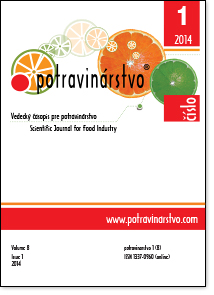Detection of native starches in meat products using histochemical Lugol Calleja method
DOI:
https://doi.org/10.5219/335Keywords:
histochemistry, food, addulteration, collagen, verification, microscopyAbstract
Starch has been still used in food industry today as one of the main additives in foodstuffs. The reason for the use of starches in foodstuffs is their ability to bind water and to contribute to the coherent structure of the final product. However, the presence of starch in some foodstuffs is limited by legislation. These are especially meat products where legislation prohibits using starches. This study deals with determination of native starches using histochemical Lugol Calleja staining in meat products. The targeted structures of this successive staining are starches and collagen ligaments. Other structures can also be detected, based on the knowledge of their morphology. Within the scope of this study, the possibility of histochemical proof on the basis of reaction between Lugol's iodine solution and starch amylose was demonstrated. From the samples analyzed, the following criteria for the method were determined: Repeatability and repeatability of intralaboratory results was 100%, selectivity was determined to be 1.03, specificity of the method was determined to be 0.9, limit of detection was established to be 100% for 0.001 g.kg-1 of the addition, and 87.7% for the concentration of 0.0001 g.kg-1 of the starch addition. Based on the results it is obvious that the method is suitable for determination of native starches in meat products, and, in combination with staining of other foodstuffs ingredients, it gives a complex view of the composition and structure of the meat product.
Downloads
Metrics
References
Atkin, N. J., Abeysekera, R. M., Cheng, S. L., Robards, A. W. 1998. An experimentally-based predictive model for the separation of amylopectin subunits during starch gelatinization. Carbohydrate polymers, vol. 36, no. 2, p. 173-192. https://doi.org/10.1016/S0144-8617(98)00003-4 DOI: https://doi.org/10.1016/S0144-8617(98)00003-4
Delrue, B., Fontaine, T., Routier, F., Decq, A., Wieruszeski, J. M., Van Den Koornhuyse, N., Maddelein, M. L., Fournet, B., Ball, S. 1992. Waxy Chlamydomonas reinhardtii: monocellular algal mutants defective in amylose biosynthesis and granule-bound starch synthase activity accumulate a structurally modified amylopectin. Journal of bacteriology, vol. 174, no. 11, p. 3612-3620. PMid:1592815 DOI: https://doi.org/10.1128/jb.174.11.3612-3620.1992
Eliášová, M., Pospiech, M., Tremlová, B., Kubíčková, K., Jandásek, J. 2012. Native and modified starches in meat products-detection of raw materials using microscopy methods, Maso International, vol. 2, p. 101-108.
Ernst, M., Bufler, G. 1994. Stems of Allium cepa L. contain starch. New phytologist, vol. 128, no. 3, p. 403-406. https://doi.org/10.1111/j.1469-8137.1994.tb02986.x DOI: https://doi.org/10.1111/j.1469-8137.1994.tb02986.x
Eurachem. 1998. The Fitness for Purpose of Analytical Methods. A Laboratory Guide to Method Validation and Related Topics, Eurachem Secretariat, Teddington, Middlesex, UK, p. 61. [cit. 14-02-11]. Retrieved from the web: http://www.eurolab-d.bam.de/eurachem_dokumente/The%20Fitness%20for%20Purpose%20of%20Analytical%20Methods%20A%20Laboratory%20Guide%20to%20Method%20Validation%20and%20Related%20Topics%20(1998).pdf
European Commission. 2002. Commission Decision 2002/657/EC of 12 August 2002 implementing Council Directive 96/23/EC concerning the performance of analytical methods and the interpretation of results. Official Journal of European Commission. L, vol. 221, p. 8-36.
Fannon, J. E., Hauber, R. J., BeMiller, J. N. 1992. Surface pores of starch granules. Cereal Chemistry, vol. 69, no. 3, p. 284-288. [cit. 14-02-11]. Retrieved from the web: http://www.aaccnet.org/publications/cc/backissues/1992/documents/69_284.pdf
International Organization for Standardization. 1994. ISO 8402 (E): 1994: Quality Management and Quality Assurance - Vocabulary. International Organization for Standardization.
ISO 5554: 1978: Meat Products - Determination of Starch Content (Reference method).
ISO 13965: 1998 (E): Meat and Meat Products - Determination of Starch and Glucose Contents - Enzymatic method.
Karlsson, M. E., Leeman, A. M., Björck, I. M., Eliasson, A. C. 2007. Some physical and nutritional characteristics of genetically modified potatoes varying in amylose/amylopectin ratios. Food Chemistry, vol. 100, no. 1, p. 136-146. https://doi.org/10.1016/j.foodchem.2005.09.032 DOI: https://doi.org/10.1016/j.foodchem.2005.09.032
Kortstee, A. J., Suurs, L. C., Vermeesch, A. M., Keetels, C. J., Jacobsen, E., Visser, R. G. 1998. The influence of an increased degree of branching on the physico-chemical properties of starch from genetically modified potato. Carbohydrate Polymers, vol. 37, no. 2, p. 173-184. https://doi.org/10.1016/S0144-8617(98)00045-9 DOI: https://doi.org/10.1016/S0144-8617(98)00045-9
Krisman C. R. 1962. A method for the colorimetric estimation of glycogen with iodine. Analytical Biochemistry, vol. 4, no. 1, p. 17-23. https://doi.org/10.1016/0003-2697(62)90014-3 PMid:14459704 DOI: https://doi.org/10.1016/0003-2697(62)90014-3
Kutík, J., Beneš, K. 1977. Permanent slides after detection of starch grains with lugol's solution. Biologia Plantarum, vol. 19, no. 4, p. 309-312. https://doi.org/10.1007/BF02923135 DOI: https://doi.org/10.1007/BF02923135
Manion, B., Ye, M., Holbein, B. E., Seetharaman, K. 2011. Quantification of total iodine in intact granular starches of different botanical origin exposed to iodine vapor at various water activities. Carbohydrate Research, vol. 346, no. 15, p. 2482-2490. https://doi.org/10.1016/j.carres.2011.08.017 PMid:21962455 DOI: https://doi.org/10.1016/j.carres.2011.08.017
Massart, D. L., Vandeginste, B. G. M., Buydens, L. M. C., De Jong, G. J., Lewi, P. J., Smeyers-Verbeke, J. 1997. Handbook of Chemometrics and Qualimetrics (Data Handling in Science and Technology). vol. 20, Elsevier, Amsterdam. ISBN: 978-0-444-82853-8
O'Rangers, J. J., Condon, R. J. 2000. Current Issues in Regulatory Chemistry, AOAC Int., Gaithersburg, Maryland, USA, p. 207.
Pospiech, M., Petrášová, M. 2013. Histochemical detection of starch with Lugol Calleja. SOP-02 Internal methodology, Departement of Vegetable Foodstuffs Hygiene and Technology, Brno, CZ. p. 8. DOI: https://doi.org/10.5219/335
Saibene, D., Seetharaman, K. 2006. Segmental mobility of polymers in starch granules at low moisture contents. Carbohydrate polymers, vol. 64, no. 4, p. 539-547. https://doi.org/10.1016/j.carbpol.2005.11.025 DOI: https://doi.org/10.1016/j.carbpol.2005.11.025
Sifre, L., André, B., Coton, J. P. 2009. Development of a system to quantify muscle fibre destructuration. Meat Science, vol. 81, no. 3, p. 515-522. https://doi.org/10.1016/j.meatsci.2008.10.009 PMid:20416597 DOI: https://doi.org/10.1016/j.meatsci.2008.10.009
Sifre, L., Coton, J. P., Andre, B., Řezačová-Lukášková, Z. 2013. Optimization of a quantitative method for muscle histology assessment. Journal of Microscopy. vol. 250, no. 1, p. 50-56. https://doi.org/10.1111/jmi.12016 PMid:23410149 DOI: https://doi.org/10.1111/jmi.12016
Suchánek, M. 1999. Qualimetry 9. The appropriateness of the analytical methods for a particular purpose. (Vhodnost analytických metod pro daný účel, in Czech) p. 61. ISBN 80-901868-7-4
Trullols, E., Ruisanchez, I., Rius, F. X. 2004. Validation of qualitative analytical methods. TrAC Trends in Analytical Chemistry, vol. 23, no. 2, p.137-145. https://doi.org/10.1016/S0165-9936(04)00201-8 DOI: https://doi.org/10.1016/S0165-9936(04)00201-8
Downloads
Published
How to Cite
Issue
Section
License
This license permits non-commercial re-use, distribution, and reproduction in any medium, provided the original work is properly cited, and is not altered, transformed, or built upon in any way.






























